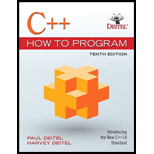
C++ How to Program (10th Edition)
10th Edition
ISBN: 9780134448237
Author: Paul J. Deitel, Harvey Deitel
Publisher: PEARSON
expand_more
expand_more
format_list_bulleted
Textbook Question
Chapter 7, Problem 7.25E
(Eight Queens: Brute Force Approaches) In this exercise, you'll develop several brute-force approaches to solving the Eight Queens problem introduced in Exercise 7.24.
a) Solve the Eight Queens exercise, using the random brute force technique developed in Exercise 7.23.
b) Use an exhaustive technique, i.e., try all possible combinations of eight queens.
c) Why do you suppose the exhaustive brute force approach may not be appropriate for solving the Knight's Tour problem?
d) Compare and contrast the random and exhaustive brute force approaches in general.
Expert Solution & Answer
Want to see the full answer?
Check out a sample textbook solution
Students have asked these similar questions
Create a relationship between the common field (Technician Number) of the two tables. Make sure that each client must have 1 and only 1 technician assigned, and each technician can have multiple clients.
2. Create a query to show the Client Number, Client Name, Billed, Paid for clients in Anderson city. Save the query.
3. Create a query to show the Technician Number, Last Name, First Name, YTD Earnings for technicians whose Hourly Rate is greater than or equal to 30. Save the query.
4. Create a query to show Client Number, Client Name, Billed, Paid for clients whose technician number is 22 and whose Billed is over 300. Save the query.
5. Create a query to show the Technician Number, Last Name, First Name, Client Number, Client Name for clients whose technician number 23. Save the query.
6. Create a query to show the Technician Number, Last Name, First Name, Client Number, Client Name for clients whose technician number 23 or 29. Save the query Help please Microsoft office access
Dijkstra's Algorithm (part 1). Consider the network shown below, and Dijkstra’s link-state algorithm. Here, we are interested in computing the least cost path from node E (note: the start node here is E) to all other nodes using Dijkstra's algorithm. Using the algorithm statement used in the textbook and its visual representation, complete the "Step 0" row in the table below showing the link state algorithm’s execution by matching the table entries (i), (ii), (iii), and (iv) with their values. Write down your final [correct] answer, as you‘ll need it for the next question.
4. |z + 5 - 5i| = 7
Chapter 7 Solutions
C++ How to Program (10th Edition)
Ch. 7 - Exercises 7.6(Fill in the Blanks) Fill in the...Ch. 7 - (True or False) Determine whether each of the...Ch. 7 - (Write C++ Statements) Write C++ statements to...Ch. 7 - (Two-Dimensional array Questions) Consider a...Ch. 7 - (Salesperson Salary Ranges) Use a one-dimensional...Ch. 7 - (One-Dimensional array Questions) Write statements...Ch. 7 - (Find the Errors) Find the error(s) in each of the...Ch. 7 - (Duplicate Elimination with array) Use a...Ch. 7 - Prob. 7.14ECh. 7 - Prob. 7.15E
Ch. 7 - (Dice Rolling) Write a program that simulates...Ch. 7 - ( What Does This Code Do?) What does the following...Ch. 7 - (Craps Game Modification) Modify the program of...Ch. 7 - (Converting vector Example of Section 7.10 to...Ch. 7 - Prob. 7.20ECh. 7 - (Sales Summary) Use a two-dimensional array to...Ch. 7 - (Knight's Tour) One of the more interesting...Ch. 7 - (Knight's Tour: Brute Forty Approaches ) In...Ch. 7 - (Eight Queens) Another puzzler for chess buffs is...Ch. 7 - (Eight Queens: Brute Force Approaches) In this...Ch. 7 - Prob. 7.26ECh. 7 - (The Sieve of Eratosthenes) A prime integer is any...Ch. 7 - Prob. 7.28RECh. 7 - (Eight Queens) Modify the Eight Queens program you...Ch. 7 - (Print an array) Write a recursive function...Ch. 7 - Prob. 7.31RECh. 7 - Prob. 7.32RECh. 7 - (Maze Traversal) The grid of hashes (#) and dots...Ch. 7 - Prob. 7.34RECh. 7 - Making a Difference 7.35 (Polling) The Internet...
Knowledge Booster
Learn more about
Need a deep-dive on the concept behind this application? Look no further. Learn more about this topic, computer-science and related others by exploring similar questions and additional content below.Similar questions
arrow_back_ios
SEE MORE QUESTIONS
arrow_forward_ios
Recommended textbooks for you
 C++ for Engineers and ScientistsComputer ScienceISBN:9781133187844Author:Bronson, Gary J.Publisher:Course Technology Ptr
C++ for Engineers and ScientistsComputer ScienceISBN:9781133187844Author:Bronson, Gary J.Publisher:Course Technology Ptr C++ Programming: From Problem Analysis to Program...Computer ScienceISBN:9781337102087Author:D. S. MalikPublisher:Cengage Learning
C++ Programming: From Problem Analysis to Program...Computer ScienceISBN:9781337102087Author:D. S. MalikPublisher:Cengage Learning Operations Research : Applications and AlgorithmsComputer ScienceISBN:9780534380588Author:Wayne L. WinstonPublisher:Brooks Cole
Operations Research : Applications and AlgorithmsComputer ScienceISBN:9780534380588Author:Wayne L. WinstonPublisher:Brooks Cole- Programming Logic & Design ComprehensiveComputer ScienceISBN:9781337669405Author:FARRELLPublisher:Cengage
 EBK JAVA PROGRAMMINGComputer ScienceISBN:9781337671385Author:FARRELLPublisher:CENGAGE LEARNING - CONSIGNMENT
EBK JAVA PROGRAMMINGComputer ScienceISBN:9781337671385Author:FARRELLPublisher:CENGAGE LEARNING - CONSIGNMENT Microsoft Visual C#Computer ScienceISBN:9781337102100Author:Joyce, Farrell.Publisher:Cengage Learning,
Microsoft Visual C#Computer ScienceISBN:9781337102100Author:Joyce, Farrell.Publisher:Cengage Learning,

C++ for Engineers and Scientists
Computer Science
ISBN:9781133187844
Author:Bronson, Gary J.
Publisher:Course Technology Ptr

C++ Programming: From Problem Analysis to Program...
Computer Science
ISBN:9781337102087
Author:D. S. Malik
Publisher:Cengage Learning

Operations Research : Applications and Algorithms
Computer Science
ISBN:9780534380588
Author:Wayne L. Winston
Publisher:Brooks Cole

Programming Logic & Design Comprehensive
Computer Science
ISBN:9781337669405
Author:FARRELL
Publisher:Cengage

EBK JAVA PROGRAMMING
Computer Science
ISBN:9781337671385
Author:FARRELL
Publisher:CENGAGE LEARNING - CONSIGNMENT

Microsoft Visual C#
Computer Science
ISBN:9781337102100
Author:Joyce, Farrell.
Publisher:Cengage Learning,
Program to find HCF & LCM of two numbers in C | #6 Coding Bytes; Author: FACE Prep;https://www.youtube.com/watch?v=mZA3cdalYN4;License: Standard YouTube License, CC-BY